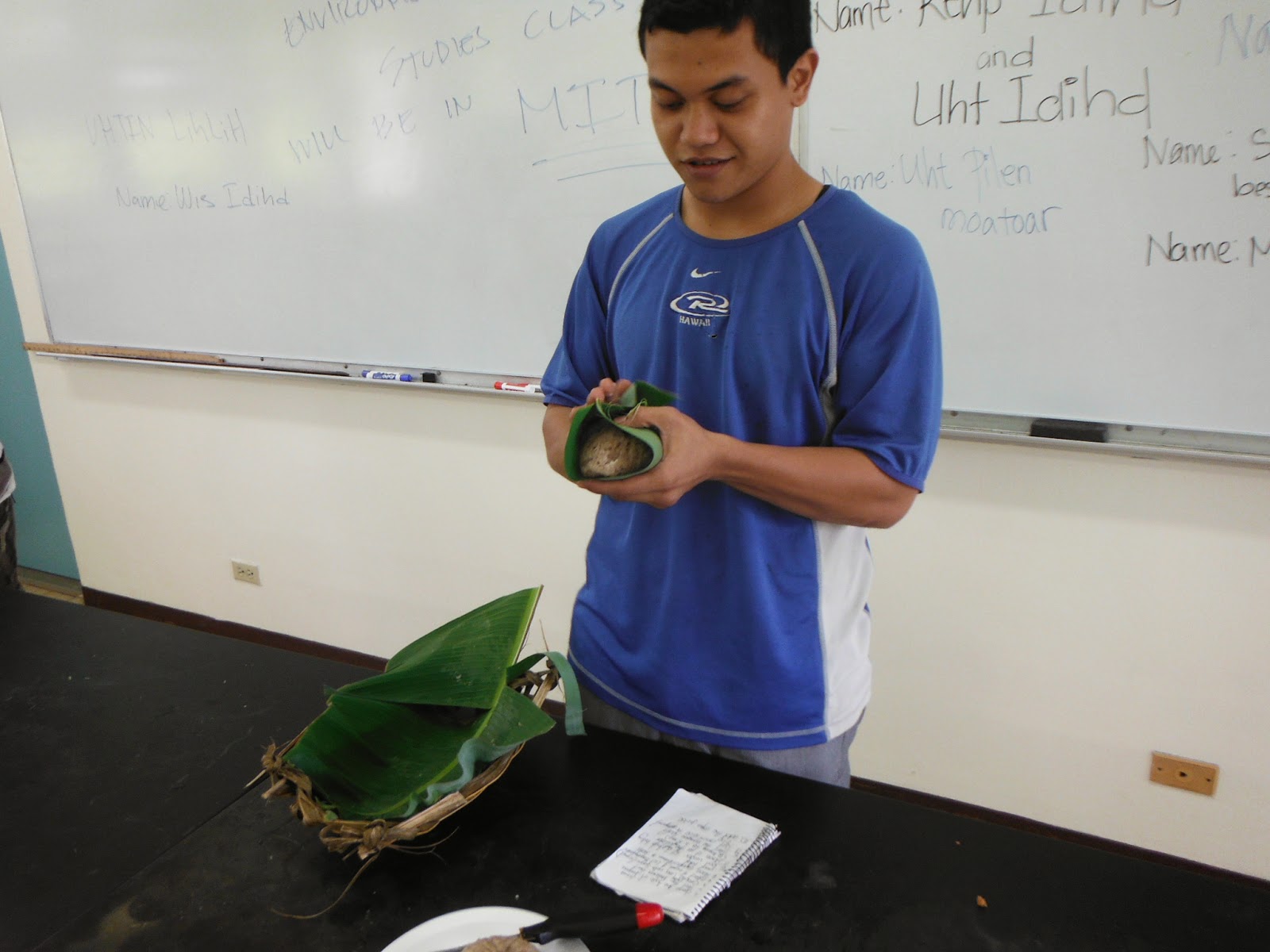Assessing Learning in Ethnobotany
SC/SS 115 Ethnobotany proposes to serve four program learning outcomes through three course level outcomes. The course serves learning outcomes in general education, the Micronesian studies program, and the Agriculture and Natural Resources program.
CLO 1
Identify local plants, their reproductive strategies, and morphology.
The twenty-four students in the course engaged in a number of activities in support of this learning outcome. Vegetative morphology for angiosperms was supported by a field hike, for ferns and gymnosperms by student presentations. Reproductive strategies were also communicated via student presentations. Identification of local plants permeated every outing, field trip, and hike.
The final examination involved a walk on campus and required the twenty-four students to identify sixteen randomly chosen local plants both by local and Latin names. The students correctly identified 375 plants by their local name of 384 possible (97%). This task is more difficult than one might expect. Despite the students being fluent in their first language, they often do not know their local plant names.
For the Latin names the students had a list of 56 Latin names from which to work. The students collectively made 323 correct Latin name matches out of 384 possible (84%).
CLO 2
Communicate and describe the cultural use of local plants for healing, as food, as raw materials, and in traditional social contexts.
Students engaged in presentations on healing plants, plants as food, and wrote two essays during the course of the term on the cultural use of plants. Essays were marked using rubrics.
The final examination asked students to provide uses for fifteen of the sixteen plants on the final examination. Students collectively provided 336 uses out of 360 possible (93%). This outcome was well met.
CLO 3
Demonstrate basic field work competencies related to management of culturally useful plant resources and foods.
Students tended to a banana tree collection and engaged in maintaining ethnobotanical plant collections on campus.
| PLO | SC/SS 115 CLO |
|---|---|
| GE 3.4 Define and explain scientific concepts, principles, and theories of a field of science. | 1. Identify local plants, their reproductive strategies, and morphology. |
| GE 4.2 Demonstrate knowledge of the cultural issues of a person’s own culture and other cultures. MSP 2 Demonstrate proficiency in the geographical, historical, and cultural literacy of the Micronesian region. | 2. Communicate and describe the cultural use of local plants for healing, as food, as raw materials, and in traditional social contexts. |
| ANR 2 Demonstrate basic competencies in the management of land resources and food production. | 3. Demonstrate basic field work competencies related to management of culturally useful plant resources and foods. |
CLO 1
Identify local plants, their reproductive strategies, and morphology.
The twenty-four students in the course engaged in a number of activities in support of this learning outcome. Vegetative morphology for angiosperms was supported by a field hike, for ferns and gymnosperms by student presentations. Reproductive strategies were also communicated via student presentations. Identification of local plants permeated every outing, field trip, and hike.
 |
| Students surrounded by Ischaemum polystachyum, with Senna alata in the background, Saccharum spontaneum in the background on the left. |
For the Latin names the students had a list of 56 Latin names from which to work. The students collectively made 323 correct Latin name matches out of 384 possible (84%).
CLO 2
Communicate and describe the cultural use of local plants for healing, as food, as raw materials, and in traditional social contexts.
Students engaged in presentations on healing plants, plants as food, and wrote two essays during the course of the term on the cultural use of plants. Essays were marked using rubrics.
 |
| Lilina Etson explains the healing use of a local plant |
 |
| Daryll Keller presented Pingalapese wis idihd - boiled ground banana. |
CLO 3
Demonstrate basic field work competencies related to management of culturally useful plant resources and foods.
Students tended to a banana tree collection and engaged in maintaining ethnobotanical plant collections on campus.
 |
| Lilina, Bryan, and Miki move a banana sucker to a new location |
The students worked with bananas from production on the land to the kitchen to the table. The collection also provided a living banana herbarium and assisted in teaching students the diversity of bananas. Twenty-three of the twenty-four (96%) students fully met this outcome.
Students also tended to ethnobotanically useful plant collections and learned to identify threats to production such as invasive species.
 |
| Daryll holds a native medicinal plant, Melastoma malabathricum var. marianum (pisetikimei), in his right hand, a n invasive, Clidemia hirta, in his left. |
 |
| Maintenance of an ethnobotanical garden on Pohnpei often happens in the rain. Lerina and Petery devise a way to clean while remaining dry. Only in ethnobotany class. |



Comments
Post a Comment